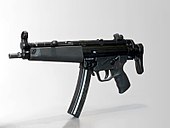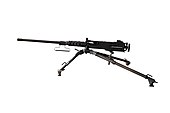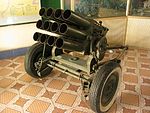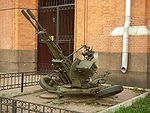Ghana Army
| Ghana Army | |
|---|---|
 | |
| Founded | 29 July 1959 (62 years ago) |
| Country | |
| Allegiance | Constitution of Ghana |
| Branch | Ghana Armed Forces |
| Type | Army |
| Role | Ground Warfare |
| Part of | |
| Colors | Scarlet, Black and Dartmouth Green |
| Commanders | |
| Chief of the Defence Staff | Vice Admiral Seth Amoama |
| Chief of the Army Staff | Major General Thomas Oppong Peprah |
The Ghana Army (GA) is the main ground warfare organizational military branch of the Ghanaian Armed Forces (GAF). In 1959, two years after the Gold Coast obtained independence as Ghana, the Gold Coast Regiment was withdrawn from the Royal West African Frontier Force, and formed the basis for the new Ghanaian army. Together with the Ghanaian air force (GHF) and Ghanaian navy (GN), the Ghanaian army (GA) makes up the Ghanaian Armed Forces (GAF), controlled by the Ghanaian Ministry of Defence (MoD) and Central Defence Headquarters, both located in Greater Accra.
History[]
The command structure for the army forces in Ghana originally stemmed from the British Army's West Africa Command. Lieutenant General Lashmer Whistler was the penultimate commander holding the command from 1951 to 1953. Lt Gen Sir Otway Herbert, who left the West Africa Command in 1955, was the last commander.[1] The command was dissolved on 1 July 1956.[2]
In 1957, the Ghana Army consisted of its headquarters, support services, three battalions of infantry and a reconnaissance squadron with armoured cars. Total strength was approximately 5,700 men.[3] Partially due to an over-supply of British officers after the end of the Second World War, only 12 per cent of the officer corps in Ghana, 29 officers out of 209, were black Ghanaians at independence.[4] Under Major General Alexander Paley, there were almost 200 British Ghanaian officers and 230 warrant officers and senior commissioned officers posted throughout the Ghanaian Army.

The Ghanaian Prime Minister, Kwame Nkrumah, wished to rapidly expand and Africanise the army to support his Pan-African and anti-colonial ambitions. In 1961, the 4th and 5th Battalions were established and the 6th Battalion in 1964, from a parachute unit originally raised in 1963.[5] The Second Infantry Brigade Group was established in 1961 to command the two battalions raised that year. The 3rd Battalion was disbanded in February 1961 after a mutiny in August 1960 while on Operation des Nations Unies au Congo service at Tshikapa in the Democratic Republic of the Congo.[6] The changeover from British to Ghanaian officers meant a sudden lowering of experience levels, training and professionalism.
The Ghanaian commanding officer of 3rd Battalion, Lieutenant Colonel David Hansen, had on appointment as battalion commander only seven years of military experience, compared to the more normal twenty years' for battalion commanders in Western armies. He was badly beaten by his troops during the mutiny.[7] The 4th Battalion was raised under a British commanding officer, Lieutenant Colonel Douglas Cairns, from the company of the 3rd Battalion that had not mutinied. Initial British planning by Paley before his departure in 1959 had provided for all British officers to be withdrawn by 1970. Under pressure from Nkrumah, Paley's successor Major General Henry Alexander revised the plans, for all British personnel to depart by 1962. In September 1961, Alexander and all other British officers and men serving with the Ghanaian armed forces were abruptly dismissed.[8] Nkrumah was determined fully to create all-Ghanaian armed forces, after some years of accelerated promotion of Ghanaian personnel.

Simon Baynham says that "the wholesale shambles which surely must have resulted from simply expelling the expatriate contract and seconded officers was averted by the arrival of Canadian military technicians and training officers".[9] Canadian training team personnel were assigned to the Military Academy (1961−1968), the Military Hospital, as Brigade Training Officers (1961−1968), to the air force and later the Ministry of Defence (1963−1968), Ghana Army Headquarters (1963−1968) and the Airborne School.[10]
Matters deteriorated further after the coup that deposed Nkrumah. Colonel James Bond, the Canadian military attaché, asked to write a report on how Canada could further assist the Ghanaian armed forces, wrote that "during 1966 the preoccupation of.. senior officers with their civilian duties as members of the National Liberation Council and as regional administrators, resulted in an unconscious neglect of the welfare of the Army".[11] Able intermediate level officers had been assigned civilian administrative duties, leaving the army short.
Ghana has contributed forces to numerous UN and ECOWAS operations, including in the Balkans, Afghanistan, Democratic Republic of the Congo, Lebanon and Liberia (ECOMOG and UNMIL). Ghana contributed UN peacekeeping in UNAMIR during the Rwandan genocide. In his book Shake Hands with the Devil, Canadian UNAMIR Force Commander Romeo Dallaire gave the Ghanaian soldiers high praise for their work during the conflict, in which the Ghanaian contingent lost three soldiers. In accordance with an official statement issued on Wednesday, 22 March 2000 by the Secretary to the President, the commanders of the 1st Infantry Brigade Group in the south and the 2nd Infantry Brigade Group in the north were appointed General Officers Commanding the Southern and the Northern Commands of the Ghana Army.[12]
Structure[]
 2nd Bn, Ghana Regt |
 Structure of the GA (Ghana Army) |
The Ghana army is divided into three brigade sized "commands":
- Northern Command (Tamale)
- 6th Battalion, Ghana Regiment
- 69th Airborne Force (One company sized formation each in Upper West and Upper East regions respectively).
- 155th Armoured Recce Regiment (planned)
- Central Command (Kumasi)
- 3rd Battalion, Ghana Regiment (Sunyani)
- 4th Battalion, Ghana Regiment (Kumasi)
- 154th Armoured Reconnaissance Regiment (Sunyani)
- 2nd Signal Squadron (Kumasi)
- 2nd Field Workshop (Kumasi)
- 49th Engineer Regiment (Kumasi)
- 2nd Field Ambulance (Kumasi)
- 2nd Transport Company (Kumasi)
- 2nd Field Operations Center (Kumasi)
- Southern Command (Accra)
- 1st Battalion, Ghana Regiment (Tema)
- 2nd Battalion, Ghana Regiment (Takoradi)
- 5th Battalion, Ghana Regiment (Accra)
- 64th Infantry Regiment (Accra)
- 153rd Armoured Reconnaissance Regiment (Accra)
- 66th Artillery Regiment (Ho)
- 48th Engineer Regiment (Teshie)
- 1st Field Workshop (Accra)
- 1 Motor Transport Battalion (Accra)
Equipment[]
Small arms[]
| Name | Origin | Notes | Images |
|---|---|---|---|
| Browning Hi-Power[13] | Semi-automatic fire arm | 
| |
| AK-47 | Assault rifle, used by honor guards. | 
| |
| Type 81 assault rifle[14] | Assault rifle | 
| |
| CAR-15 | Carbine rifle, used by paratroopers. | 
| |
| M16A2[15] | Standard issue rifle. | 
| |
| M4 carbine[15] | Used by paratroopers. | 
| |
| HK G3[16] | Battle rifle | ||
| FN FAL[13] | Battle rifle | ||
| MP5[17] | Submachine gun | 
| |
| Sterling submachine gun | Submachine gun | 
| |
| FN MAG[18] | General purpose machine gun | 
| |
| Rheinmetall MG 3 | General purpose machine gun | 
| |
| M60 machine gun[19] | General purpose machine gun | ||
| Bren[13] | Light machine gun | 
| |
| DShK[13] | Heavy machine gun | 
| |
| M2 Browning[13] | Heavy machine gun | 
| |
| 9K32 Strela-2[20] | Man-portable air-defense system | 
| |
| Carl Gustaf[13] | Anti-tank recoilless rifle | 
|
Artillery[]
| Name | Image | Type | Origin | Caliber | Numbers |
|---|---|---|---|---|---|
| Tampella 120 Krh/40 |  |
Mortar | 120mm | 28[21] | |
| D-30 towed artillery |  |
Howitzer | 122mm | 6[21] | |
| Type 63 |  |
Multiple rocket launcher | 106.7mm | uncertain[21] | |
| Type 81 |  |
Self-propelled rocket launcher | 122mm | 3[21] | |
| ZU-23-2 |  |
Anti-aircraft twin autocannon | 23mm | 4[21] | |
| ZPU 2 and 4 |  |
Anti-aircraft gun | 14.5mm | 4[21] |
Armoured fighting vehicles[]
| Name | Image | Type | Origin | Numbers |
|---|---|---|---|---|
| Casspir |  |
MRAP | 4[22] | |
| STREIT Group Typhoon | MRAP | 50[15] | ||
| EE-9 Cascavel |  |
Armoured car | 3[21][23] | |
| Alvis Saladin |  |
Armoured car | 15 as of 2015[24] | |
| Alvis Tactica |  |
Armoured vehicle | 20 | |
| Ratel IFV |  |
Infantry fighting vehicle | 39[21][25] | |
| Otokar Cobra[26][27] |  |
Infantry mobility vehicle | 73 (Both versions of Otokar Cobra I - II)[28] | |
| VBTP-MR Guarani |  |
Armoured personnel carrier | 11[29] | |
| Mowag Piranha I[30][31] |  |
Armoured personnel carrier | 63 Piranha I 4×4,6×6 and 8×8 | |
| ZFB-05 | Armoured personnel carrier | 48[32] | ||
| WZ-523 |  |
Armoured personnel carrier | 58 delivered in 2009-2010 4 ambulance version delivered in 2012 and 24 others in 2013 |
Infantry[]
The Ghanaian Army consists of three distinct infantry elements:
- Ghana Regiment – The major element of the army is the six light infantry battalions of the Ghana Regiment. Three battalions are assigned to each brigade.
- Airborne Force – The Airborne Force (ABF) is a battalion sized formation including a parachute trained company assigned to the Northern Command.
- 64 Infantry Regiment – 64 Infantry Regiment is the commando trained rapid reaction force assigned to the Southern Command (formerly known as President's Own Guard Regiment).
Combat support[]

The Ghanaian Army has a number of units designated as combat support, including its armour, artillery, engineers and signals:
- Reconnaissance Armoured Regiment
- 154 Armoured Reconnaissance Regiment (fondation in 2020)[33]
- 48 Engineer Regiment (Teshie, Greater Accra Region)
- 49 Engineer Regiment
- 66 Artillery Regiment (Volta Barracks, Ho; formed 2004 from previous Medium Mortar Regiment)
- Signals Regiment (Accra)
- Logistics Group
Most are under the command of the .
Rank structure[]

The GA rank structure is similar to the British army ranks structure.
- Commissioned officers
| Rank group | General/flag officers | Field/senior officers | Junior officers | Officer cadet | ||||||||||||||||||||||||||||||||
|---|---|---|---|---|---|---|---|---|---|---|---|---|---|---|---|---|---|---|---|---|---|---|---|---|---|---|---|---|---|---|---|---|---|---|---|---|

|

|

|

|

|

|

|

|

|

|

|
||||||||||||||||||||||||||
| Field marshal | General | Lieutenant general | Major general | Brigadier | Colonel | Lieutenant colonel | Major | Captain | Lieutenant | Second lieutenant | ||||||||||||||||||||||||||
- Enlisted
| Rank group | Senior NCOs | Junior NCOs | Enlisted | |||||||||||||||||||||||||||||||||
|---|---|---|---|---|---|---|---|---|---|---|---|---|---|---|---|---|---|---|---|---|---|---|---|---|---|---|---|---|---|---|---|---|---|---|---|---|

|

|
No insignia | ||||||||||||||||||||||||||||||||||
| Warrant Officer Class 1 | Warrant Officer Class 2 | Staff Sergeant | Sergeant | Corporal | Lance Corporal | Private (or equivalent) | ||||||||||||||||||||||||||||||
References[]
- ^ Generals.dk
- ^ Hansard, Defence: West Africa
- ^ Christopher R. Kilford, The Other Cold War: Canada's Military Assistance to the Developing World 1945–75, Canadian Defence Academy Press, Kingston, Ontario, 2010, p.138
- ^ Kilford, 137
- ^ Simon Baynham, The Military and Politics in Nkumrah's Ghana, Westview, 1988, Chapter 4
- ^ For the Tshikapa mutiny see Henry Alexander, African tightrope. My two years as Nkrumah's Chief of Staff (Pall Mall Press, London, 1965) pp. 67–-71
- ^ Kilford, 141
- ^ Kilford, 140
- ^ Baynham, 1988, p.125
- ^ Kilford, 141, citing Gary Hunt, “Recollections of the Canadian Armed Forces Training Team in Ghana, 1961–1968, Canadian Defence Quarterly, April 1989, 44
- ^ Kilford, 156, citing Canada, LAC, “Discussion Paper – Canadian Forces Attaché – Ghana Armed Forces and Canadian Military Assistance,” 12 July 1967, 2. RG 25, External Affairs, Vol. 10415, File 27-20-5 Ghana (Part 4).
- ^ 'Daily Graphic' of 23 March 2000, cited in Henry Kwami Anyidoho, "My Journey... every step," Sub-Saharan Publishers, Ghana, 2010, p.273.
- ^ Jump up to: a b c d e f Jones, Richard D. Infantry Weapons 2009/2010. Jane's; 35 ed. (January 27, 2009). ISBN 978-0-7106-2869-5.
- ^ News Ghana (2016-05-08). "Ghana Armed Forces Hold Annual Open Day". newsghana.com.gh. Archived from the original on 6 June 2016. Retrieved 2017-06-14.
- ^ Jump up to: a b c Binnie, Jeremy; de Cherisey, Erwan (2017). "New-model African armies" (PDF). Jane's. Archived from the original (PDF) on 22 June 2017.
- ^ Jane's infantry weapons, 2009-2010 2009/2010 (35th ed.). Jane's Information Group. 5 January 2009. ISBN 978-0-7106-2869-5.
- ^ Jones & Ness 2009, p. 514.
- ^ Jones & Ness 2009, pp. 896–898.
- ^ "M60 - SALW Guide". salw-guide.bicc.de. Retrieved 12 March 2020.
- ^ https://www.armyrecognition.com/ghana_ghanaian_army_land_ground_forces_uk/ghana_ghanaian_army_land_ground_armed_defense_forces_military_equipment_armored_vehicle_intelligence.html
- ^ Jump up to: a b c d e f g h International Institute for Strategic Studies (2020). "Chapter Nine: Sub-Saharan Africa". The Military Balance. 120 (1): 480. doi:10.1080/04597222.2020.1707971.
- ^ "Trade Registers". Armstrade.sipri.org. Archived from the original on 14 April 2010. Retrieved 2015-01-01.
- ^ Jane's Tank recognition guide (4th ed.). Collins. 2006. p. 349. ISBN 978-0007183265.
- ^ "Trade Registers". Armstrade.sipri.org. Retrieved 2015-11-03.
- ^ Wezeman, Pieter (January 2011). "South African Arms Supplies to Sub-Saharan Africa" (PDF). Stockholm: Stockholm International Peace Research Institute. Archived from the original (PDF) on 18 March 2018. Retrieved 18 March 2018.
- ^ Ghana procures Turkey’s Otokar Cobra armoured vehicles to combat terrorism. www.dailymailgh.com. aufgerufen am 14. November 2020
- ^ Ghana operating Otokar Cobra armoured vehicles. www.defenceweb.co.za. aufgerufen am 14. November 2020
- ^ "Ghana parades Cobra armoured vehicles". Defence Web. Retrieved 2021-08-09.
- ^ Exército (7 July 2021). "Anunciada exportação do Guarani para Gana". Tecnodefesa.
- ^ "UN Register of Conventional Arms – UNODA". disarmament.un.org. Archived from the original on 2008-12-14. Retrieved 2009-01-07.
- ^ Ghana Armed Forces Archived 2008-04-02 at the Wayback Machine
- ^ https://www.armyrecognition.com/ghana_ghanaian_army_land_ground_forces_uk/ghana_ghanaian_army_land_ground_armed_defense_forces_military_equipment_armored_vehicle_intelligence.html
- ^ https://www.gafonline.mil.gh/news/315
Bibliography[]
- Christopher R. Kilford, The Other Cold War: Canada's Military Assistance to the Developing World 1945-75, Canadian Defence Academy Press, Kingston, Ontario, 2010
- Jones, Richard D.; Ness, Leland S., eds. (2009). Jane's Infantry Weapons 2009/2010 (35th ed.). Coulsdon: Jane's Information Group. ISBN 978-0-7106-2869-5.
Further reading[]
- Lt Col Festus B Aboagye, The Ghana Army: A Concise Contemporary Guide to its Centennial Regimental History, 1897–1999, Sedco Publishing, Accra, 1999
- William F. Gutteridge, "The Military in African Politics," Methuen, 1969
External sources[]
- Official Website of the Ghana Armed Forces
 Media related to Ghana Army at Wikimedia Commons
Media related to Ghana Army at Wikimedia Commons
- Military units and formations established in 1957
- Military of Ghana

